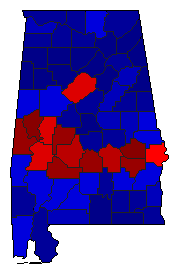Take a look at this map. It is of Alabama. The blue counties depict those that Donald Trump carried in the 2016 presidential election; the counties in red show those that voted for Hillary Rodham Clinton.
The red swath across the middle of Alabama is what is known as the “Black Belt.”
Check it out here.
I became aware of the Black Belt while visiting my dear friend and former colleague, the late Claude Duncan, in 1985. I had attended a conference in Atlanta and I stopped for a brief visit in Tuscaloosa, where Claude lived. We went to the race track one evening in Green County, the heart of the Black Belt, to bet on some greyhounds. We were among the very few white guys in the crowd.
Duncan told me how this part of Alabama is as reliably Democratic as many parts of Texas used to be before the Lone Star State converted from Democrat to Republican.
I thought of Claude the Saturday night as I watched Joe Biden pile up that big win in South Carolina, carried over the finish line after lapping the field on the backs of the African-American vote that rallied to the former vice president’s cause.
And then I thought of how Biden might fare in Alabama, which is one of 14 states voting Tuesday in the Democratic Party presidential primary, aka Super Tuesday.
There was a lot of talk about Biden’s “firewall” of African-American support in South Carolina. I am wondering now if the ex-VP can parlay that black voter support into a big payoff in Alabama and in other states with large numbers of African-American voters.
Greene County voted 82 percent for Hillary in 2016, even though only 4,880 ballots were cast. The Black Belt, though, contains many other more populous counties, such as Montgomery County, that also voted heavily for Clinton over Trump.
If Joe Biden can parlay a 60 percent black vote in South Carolina into something similar in Alabama, Tennessee and Arkansas on Super Tuesday, he might be able to withstand the onslaught of delegates Bernie Sanders is slated to win in California and New England.
